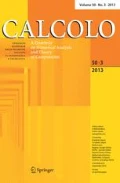Abstract
We study a velocity–vorticity scheme for the 2D incompressible Navier–Stokes equations, which is based on a formulation that couples the rotation form of the momentum equation with the vorticity equation, and a temporal discretization that stably decouples the system at each time step and allows for simultaneous solving of the vorticity equation and velocity–pressure system (thus if special care is taken in its implementation, the method can have no extra cost compared to common velocity–pressure schemes). This scheme was recently shown to be unconditionally long-time \(H^1\) stable for both velocity and vorticity, which is a property not shared by any common velocity–pressure method. Herein, we analyze the scheme’s convergence, and prove that it yields unconditional optimal accuracy for both velocity and vorticity, thus making it advantageous over common velocity–pressure schemes if the vorticity variable is of interest. Numerical experiments are given that illustrate the theory and demonstrate the scheme’s usefulness on some benchmark problems.





Similar content being viewed by others
References
Babuska, I.: Error bounds for finite element methods. Numer. Math. 16, 322–333 (1971)
Bochev, P.: Negative norm least-squares methods for the velocity–vorticity–pressure Navier–Stokes equations. Numer. Methods Partial Differ. Equ. 15(2), 237–256 (1999)
Brenner, S., Scott, L.R.: The Mathematical Theory of Finite Element Methods, 3rd edn. Springer, Berlin (2008)
Brezzi, F.: On the existence, uniqueness and approximation of saddle point problems arising from Lagrange multpliers. R.A.I.R.O 8, 129–151 (1974)
Charnyi, S., Heister, T., Olshanskii, M., Rebholz, L.: On conservation laws of Navier–Stokes Galerkin discretizations. J. Comput. Phys. 337, 289–308 (2017)
Ervin, V.J., Heuer, N.: Approximation of time-dependent, viscoelastic fluid flow: Crank–Nicolson, finite element approximation. Numer. Methods Partial Differ. Equ. 20, 248–283 (2003)
Girault, V., Raviart, P.A.: Finite Element Methods for Navier–Stokes Equations: Theory and Algorithms. Springer, Berlin (1986)
Gresho, P., Sani, R.: Incompressible Flow and the Finite Element Method, vol. 2. Wiley, New York (1998)
Gresho, P.M.: On the theory of semi-implicit projection methods for viscous incompressible flow and its implementation via a finite element method that also introduces a nearly consistent mass matrix. Part 1: theory. Int. J. Numer. Methods Fluids 11(5), 587–620 (1990)
Heath, M.: Scientific Computing: An Introductory Survey. McGraw-Hill, New York (2002)
Heister, T., Olshanskii, M. A., Rebholz, L. G.: Unconditional long-time stability of a velocity–vorticity method for 2D Navier–Stokes equations. Numerische Mathematik 135(1), 143–167 (2016)
Heywood, J., Rannacher, R.: Finite element approximation of the nonstationary Navier–Stokes problem. Part IV: error analysis for the second order time discretization. SIAM J. Numer. Anal. 2, 353–384 (1990)
John, V.: Large Eddy Simulation of Turbulent Incompressible Flows: Analytical and Numerical Results for a Class of LES Models. Lecture Notes in Computational Science and Engineering. Springer, Berlin (2004)
Ladyzhenskaya, O.: The Mathematical Theory of Viscous Incompressible Flow. Gordon and Breach Science Publishers, New York (1969)
Layton, W.: Introduction to Finite Element Methods for Incompressible, Viscous Flow. SIAM, Philadelphia (2008)
Layton, W., Manica, C.C., Neda, M., Olshanskii, M., Rebholz, L.G.: On the accuracy of the rotation form in simulations of the Navier–Stokes equations. J. Comput. Phys. 228, 3433–3447 (2009)
Lee, H.K., Olshanskii, M.A., Rebholz, L.G.: On error analysis for the 3D Navier–Stokes equations in velocity–vorticity–helicity form. SIAM J. Numer. Anal. 49(2), 711–732 (2011)
Liska, R., Wendroff, B.: Comparison of several difference schemes on 1D and 2D test problems for the Euler equations. SIAM J. Sci. Comput. 25, 995–1017 (2003)
Najjar, F., Vanka, S.: Simulations of the unsteady separated flow past a normal flat plate. Int. J. Numer. Methods Fluids 21, 525–547 (1995)
Olshanskii, M.A., Rebholz, L.G.: Velocity–vorticity–helicity formulation and a solver for the Navier–Stokes equations. J. Comput. Phys. 229, 4291–4303 (2010)
Olshanskii, M.A., Heister, T., Rebholz, L., Galvin, K.: Natural vorticity boundary conditions on solid walls. Comput. Methods Appl. Mech. Eng. 297, 18–37 (2015)
Saha, A.: Far-wake characteristics of two-dimensional flow past a normal flat plate. Phys. Fluids 19(128110), 1–4 (2007)
Saha, A.: Direct numerical simulation of two-dimensional flow past a normal flat plate. J. Eng. Mech. 139(12), 1894–1901 (2013)
Schroeder, P., Lube, G.: Pressure-robust analysis of divergence-free and conforming fem for evolutionary incompressible Navier–Stokes flows. J. Numer. Math. (2016). https://doi.org/10.1515/jnma-2016-1101
Tezduyar, T., Mittal, S., Ray, S., Shih, R.: Incompressible flow computations with stabilized bilinear and linear equal order interpolation velocity–pressure elements. Comput. Methods Appl. Mech. Eng. 95, 221–242 (1992)
Tone, F.: On the long-time stability of the Crank–Nicholson scheme for the 2D Navier–Stokes equations. Numer. Methods D. E. 23(5), 1235–1248 (2007)
Tone, F., Wirosoetisno, D.: On the long-time stability of the implicit Euler scheme for the two-dimensional Navier–Stokes equations. SIAM J. Numer. Anal. 44(1), 29–40 (2006)
Wong, K.L., Baker, A.J.: A 3D incompressible Navier–Stokes velocity–vorticity weak form finite element algorithm. Int. J. Numer. Methods Fluids 38, 99–123 (2002)
Author information
Authors and Affiliations
Corresponding author
Additional information
L. G. Rebholz: Partially supported by NSF Grant DMS 1522191 and U.S. Army Grant 65294-MA.
C. Zerfas: Partially supported by NSF Grant DMS 1522191.
Rights and permissions
About this article
Cite this article
Akbas, M., Rebholz, L.G. & Zerfas, C. Optimal vorticity accuracy in an efficient velocity–vorticity method for the 2D Navier–Stokes equations. Calcolo 55, 3 (2018). https://doi.org/10.1007/s10092-018-0246-7
Received:
Accepted:
Published:
DOI: https://doi.org/10.1007/s10092-018-0246-7




